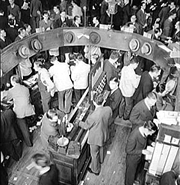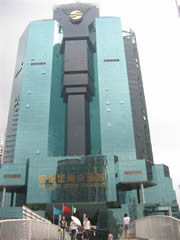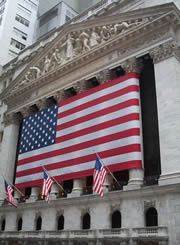Demutualized Stock Exchanges Change Stockbrokers’ Role
Over the last twenty years, stock exchanges have morphed into a new type of institution: the ‘demutualized exchange’.
The position and power of stockbrokers — once the ‘masters of the investment universe’ — has been significantly lessened.
“Demutualization” is the process by which a stock exchange is transformed from the traditional configuration of a broker-owned, club-like, non-profit organization, dedicated to serving the interests of broker-members, into a for-profit corporation, owned by general investors, with the goal of serving “customers” or “market participants” and making money in the “stock exchange business”
This is a accelerating global phenomenon, seemingly irreversible, that will effect the influence of stockbrokers and, consequently, the flow of funds.
Considering the role that stockbrokers now play in the great stock-buyback-option schemes (See: The Great Misleading) that have boosted equity prices for a generation, any lessening in their power or political clout is likely to have a significant long-term effect on stock prices.
By the time the baby boomers begin to cash out their retirement funds, exchange institutional frameworks and interests of the new “Masters of the Universe” will be considerably different than in today’s market.
Stockbrokers: No Longer Kings of the Hill?
Since the days of the London coffee houses, stockbrokers have been essential in organizing capital markets. It was stockbrokers that banded together to form the first stock exchanges, setting up listing and trading rules. Stockbrokers beat the bushes to find investors and issuers that were essential in creating capital markets.
In Europe, outside of the United Kingdom, stock exchanges were often set up by governments or banks, with ‘official members’ and special privileges. Government sponsored exchanges were generally less successful than free-wheeling, private exchanges in the United States and the British Empire.
Until the 1920s, most stock exchanges were still managed by brokers themselves and were run as restrictive, private clubs with limited membership.
In the most dynamic markets of the 19th and early-20th centuries — New York and London -stock brokers were partnerships, operating with unlimited personal liability and bound by a self-imposed code of ethics that declared, “My word is my bond“.
Those days of highly personal ethical responsibility are long gone.
Dramatic Events Herald Change
After the crash of 1929, the heavens began to shift, although very slowly at first.
During the 1930s, the new US Securities and Exchange Commission encouraged exchanges to hire ‘professional’ managers and began to oversee exchange rules and operations. Nevertheless, stockbrokers’ business interests continued to be the main consideration behind stock exchange policy.
 Most Exchanges Are Now Floorless
|
||
In most exchanges, the top ten percent of members account for most trading. However, with one vote per seat, the ninety percent of less active, poorly-capitalized members are able to brake innovation.
The New York Stock Exchange hung on to its out-moded, broker-intensive trading floor, long after modern floorless trading systems were introduced in Singapore, Kuala Lumpur, Bangkok, Taiwan, Paris, London, and other markets.
Richard Grasso’s Legacy
In August 2003, it was found that Richard Grasso, the chief executive of the New York Stock Exchange, had been given a deferred compensation pay package worth almost $140 million — more than the capital and reserves of most exchange member firms.
This pay package brought to light the fact, even to the slowest minds, that stock exchanges were not really ‘not-profit’ institutions at all, but rather highly profitable businesses in themselves.
The scandal was so great and the awakening so thorough that within two years the New York Stock Exchange had ‘demutualized’ and merged with ArcaEx, an entirely online exchange that was eating into its business.
By January 2007, hundreds of floor traders on the NYSE had lost their jobs as, at long last, the exchange began to catch up with more modern exchanges practices, already proven overseas.
Now, the New York Stock Exchange is in process of merging with Paris-Amsterdam based Euronext, billed as a “merger of equals” — a designation that would have been considered absurd fifty years ago, when New York was indeed the center of the world capital markets.
Although a lobby of Wall Street interests is blaming the Sarbanes-Oxley Act for loss of competitive advantage in foreign capital markets, the real explanation is somewhat different: the world has been modernizing the exchange business, while Wall Street has resisted change, focusing on short-term profits.
A Generation of Radical Change
The crash of the New York Stock Exchange in October 1987 and the dissolution of the Soviet Union in December 1991 triggered events that introduced fundamental innovations in stock markets throughout the world.
The Crash of 1987 heightened worries about the safety of clearing and settlement systems, leading a “Group of Thirty” international banks to advocate modernization of stock exchange back-end services throughout the world (See: Globalization and Capital Flows). Over the next two decades, fundamental (but commonsense) changes in exchange practices were introduced:
 Shenzhen Stock Exchange
|
||
Central Securities Depositories were established. Today there are more than four dozen central securities depositories, even in countries that did not have a stock exchange in 1987.
Shortened settlement times. In 1987, some important securities markets only settled trades fortnightly. The Group of Thirty (G30) advocated shortening settlement times to four days, or less. Short settlement times are now virtually universal.
Delivery against payment. In 1987, in some markets settlement was extremely sloppy, with securities delivered without payment. G30 recommendations brought about universal acceptance of the ‘delivery versus payment’ standard (DVP), and vast improvement in clearing and settlement discipline.
Much of the success of G30 was due to active participation of international organizations, specifically IOSCO (International Organization of Securities Commissions), the World Federation of Exchanges, the International Securities Services Association, the Bank for International Settlements, and regional associations.
The World Bank, the United States Agency of International Development, the International Monetary Fund, the Asian Development Bank, and other similar suppliers of development funds, supported G30 recommendations and encouraged and financed the development of capital markets in every corner of the world.
The end of the Soviet Union in 1991, set off a race to set up stock markets in former communist and Soviet block countries, from China to Belarus. Today, its hard to find a country that doesn’t have a stock exchange with modern trading procedures. These new exchanges often feature:
- Floorless, computerized trading, with order-driven systems linked to clearings and settlement at a central securities depository;
- Demutualized ownership;
- Dematerialized securities, immobilized in a Central Securities Depository;
- International standardized numbering of securities in order to link to worldwide clearings and settlement systems;
- Supervision by a securities regulator, often modeled after the US Securities and Exchange Commission, or (more recently), the UK Financial Services Authority.
Another radical change that occurred in the last generation was the emergence of computerized cross-border exchanges, first created out of necessity from the European Union. Here we see Euronext, uniting exchanges in France, the UK, the Netherlands, Spain, Belgium, and Portugal; and the Nordic Exchange (OMX) that brings together markets in Denmark, Sweden, Finland, Iceland, Estonia, Lithuania, and Latvia.
Cross-border exchanges and securities regulation also emerged among small countries in Africa and the Caribbean: the Eastern Caribbean Securities Exchange; the Economic and Monetary Community of Central Africa; and the West African Economic and Monetary Union.
Towards T+0 and Profiting from the Float
Read the ‘mission statement’ of almost any demutualized exchange and you will find a pledge to provide service for “customers” or “market participants”. This is far different than dedication to “members”, with only lip-service for others.
The new ‘independent’ directors of the demutualized New York Stock Exchange do not include member firms. This means that stockbrokers, especially the large brokers that have dominated the market up until now, make up only a small part of the extensive potential clientèle of the demutualized exchange, which includes millions of investors, thousands of fund managers, and other non-broker market participants.
Millions of investors now buy and sell securities directly from their home computers, without talking to a stockbroker. However, the cash in their securities account sits at the brokerage firm, and the interest on the float goes to the broker. In December 2006, US households maintained over $644 billion in free credit balances with stockbrokers — the interest on which is important source of broker income — amounting to at least $32 billion per year, just from individuals! (This is 18 times the total revenue of the NYSE in 2006.)
Now it shouldn’t take long before an executive in a demutualized exchange somewhere in the world, figures out that there are many investors that don’t need stockbrokers at all, and who would be happy to open a trading account directly with the stock exchange, in order to gain immediate settlement of trades and extremely low commissions.
The Taiwan Stock Exchange, a highly successful, computerized market, limits maximum broker commissions to 0.1425% of the value of a trade — about half the rate of commissions charged by discount brokers in the US! If the stock exchange were to eliminate the broker entirely, capturing the float on the trade and the benefits of direct, multi-lateral T+0 settlement, client-to-client, commissions might be lower than 0.1%.
In other words, when ‘independent’ directors of a stock exchange have to serve investors in the exchange, rather than stockbroker members, the logic of profit and loss will soon put them in the position of having to choose between the interests of the small number of brokers that channel trades to the exchange and their own investors, who may not be brokers at all.
Competing with Mutual Funds and Standard & Poors
Stock exchanges already offer Exchange Traded Funds as proprietary products. If exchanges, in their drive to increase profits for shareholders, are successful in getting investors to open accounts directly with the exchange (rather than through stockbrokers), it won’t be much of a step (with modern computer software) to devise a system by which clients can designated their own ‘named virtual funds’ in their own portfolios, with the ability to automatically add or withdraw funds by a single order.
The position of the stock exchange as gatherer of information from issuers, makes it feasible for them to require listing companies to provide information in a standard computerized format, that could be available immediately to investors online through accounts with the exchange. Watch out Standard & Poor’s: you may also become obsolete!
Moving Away From New York City
As a demutualized stock exchange, responsible to investors throughout the world, the New York Stock Exchange may find it harder to justify staying in New York City.
As the exchange modernizes, it will inevitably follow the path of exchanges elsewhere and go floorless. Once this happens, there will be little economic justification for staying in New York City.
As a demutualized exchange, dealing in world markets, most of its clients will be located outside of New York City. Stockbrokers will no longer be the prime clients.
Triple income taxes levied on corporations in Manhattan, plus taxes on exchange transactions and the high cost of wages in New York City, fanned by out-moded rent control laws, poor conditions for raising children, and generally high costs of living, makes moving to a low cost city elsewhere a good option to keep costs contained.
The increasing risk of terrorist attack on Manhattan, including atomic attack, makes moving the exchange staff and its computers elsewhere logical good business sense.
Of course, Mayor Bloomberg and Senator Schumer, if they are still in office when the time comes, will rant and rave at any suggestion of the Big Board moving away, but as a demutualized exchange responsible to investors that may be located anywhere, they may not have much to say in the matter.
Good News for Investors … Maybe
Now I’m quite aware that predictions regarding the future of stock exchanges are usually met with disbelief by market participants.
I’ve been making such forecasts professionally, as far back as the Rio de Janeiro Stock Exchange in the 1960s, and the Jakarta Stock Exchange in the 1990s, and have found that even the wildest expectations, pooh-poohed at the time, were, in fact, conservative compared to what actually happened in coming years. And that was when stockbrokers still controlled exchanges and were in a position to block modernization.
 Why Is NYSE Still in NYC?
|
||
With today’s demutualized exchanges and international competition between markets, new ideas are likely to flourish and come to fruition more quickly than in the past. This could be to the benefit of ordinary investors, leading to lower transaction costs, better integration between investor information and trading platforms, and less expensive management of portfolios of securities. I would also expect trading facilities for bonds to improve significantly, as exchanges move to modernize income products for retiring baby boomers.
In any event, the role of stockbrokers as a dominant force in determining capital market structure seems likely to diminish, which, when combined with the changing interests of baby boomers and their need for income securities, may lead to the debunking of the Common Stock Legend, the return of dividends as king, and the end of the stock buyback/executive option scam.
It’s a hope, anyway.

 Click these icons to email articles to friends.
Click these icons to email articles to friends.